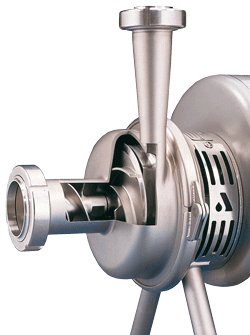Sanitary Centrifugal Pumps for Low NPSH Situations
We have covered in previous posts why by design sanitary centrifugal pumps are not as efficient as some of the industrial pumps on the market today. Besides being less efficient, they generally have higher NPSH requirements than an equivalent industrial pump. The sanitary process industry, however, does not have a shortage of low NPSH applications. In fact there are several common sanitary applications that have even harder challenges on the suction side of the pump than low NPSH. One of the worst low NPSH applications is CIP return where the fluid to be pumped often has a lot of entrained air and foam.
To meet those needs, sanitary pump manufacturers have come up with some innovative pumping technologies. We will cover some of those today, including sanitary liquid ring pumps and inducer pumps.
What is Pump Airlock?
Cavitation and dry running are not the only issues users will run into when using a centrifugal pump in a low NPSHA application. Air locking is another common problem. Air lock happens when air or dissolved gas gets “trapped” in the volute of the pump. As the gas collects, it is compressed and creates an artificial discharge head. Pressure builds until shut-off head is reached. Air lock most often happens when there is a leak in the suction line (word to the wise, Teflon gaskets leak), but can also occur when pumping products with entrained air.
The following technologies not only help in low NPSHA applications, but also help mitigate the risk of air lock.
Inducer Pumps
An inducer is basically an auger type device (SPX calls it an axial flow impeller) that mounts to the hub of the pump impeller and spins as the impeller spins. The throat on the inlet of the pump is extended and houses the inducer with fairly tight tolerances. As eccentric inducer spins, it boosts the inlet pressure. This normally reduces the NPSHR by 50-70%. The inducer also greatly reduces the risk of cavitation. It can also let the pump handle more viscous products and products with entrained air better than standard sanitary centrifugal pumps. The APV Wi+ is the pump we normally work with that has an inducer. The inducer pump is still not considered self-priming.
Liquid Ring Pumps
Sanitary liquid rings pumps are somewhat of a hybrid type pump, part centrifugal and part PD pump. The pump has a veined impeller with a closed ring around the outside. The impeller is mounted within a casing with very close tolerances. The back plate of the pump has channels machined into it. As the impeller rotates, these channels create high and low pressure areas, simultaneously pulling liquid into the pumps inlet and forcing liquid through the outlet. These three characteristics (impeller design, tight tolerances, and casing/back plate design) allow liquid ring pumps to be self-priming when half-filled with liquid. Our normal choice of liquid ring pumps is the Waukesha LR. It is self-priming.
Self-Priming Inducer Pumps
APV makes a unique self-priming pump called the Ws+ Series that is self-priming. It features the same inducer as in the Wi+. They then pipe a liquid leg from the discharge outlet of the pump directly to the chamber that houses the inducer. The constant fluid recirculation allows the pump to self-prime and pump foam or air entrained products better.
Which Pump for Which Application?
Like anything else, choosing the right pump is a cost benefit exercise. Listed below is our take on the pluses and minuses of each pump.
- The Wi+ inducer pump is the least expensive of the group and is available in a broad range of sizes. It also has the highest flow and pressure output capability of this group. The drawback is that the Wi+ will not handle foam and entrained air as well as the other two and it is not self-priming.
- The self-priming Ws+ is designed to handle CIP return and other fluids with entrained air and foam. The pump offers multiple impeller sizes to best fit the application and runs with less noise than a traditional liquid ring pump. Where most liquid ring pumps have one impeller size and need vertical inlet and discharge piping, the APV Ws+ pump can be piped with a horizontal inlet.
- Another advantage to the Wi+ and Ws+ pumps is that they both share many of the same components as the W+ pump. Existing Wi+ pumps can also be converted to Ws+ pumps relatively easily
- The Waukesha LR sanitary liquid ring pump is a workhorse. It was brought onto market to handle CIP return duties, but because of its design it can handle some other unique duties as well. The LR is bi-directional, meaning if you reverse the rotation of the pump it will reverse the flow. No other sanitary centrifugal pump that we know of can do that. The LR comes in two sizes and is the most expensive choice among this group. For best application results, it is best to pipe the inlet and discharge piping with a vertical leg going into and out of the pump. This will ensure the pump maintains its prime.
So there are the sanitary centrifugal pumps on the market designed specifically for applications with challenging suction head requirements. Contact us if you have any questions about low NPSH sanitary pumps. We have put pumps is many of these types of applications, from pumping out of tanks under vacuum to foamy CIP return situations. If you come up with an application we have not seen before, we will figure it out together.









